Codec independence issues aside, Sony devices became more viable with the release of Sonicstage 3.2. ATRAC files can now be unencrypted and the new bitrates are welcome. 160~192K ATRAC3+ is pretty much the ideal blend of quality and storage efficiency.
The core sound quality of the HD5 still needs work (the 'HD5's got a secret' tweak alone is not what irked me... the lower sound quality is the kicker) but apart from that, for the more casual ad-hoc listener the NW-HD5 is now looking pretty good.
Saturday, July 30, 2005
Friday, July 29, 2005
Thinking about a revamp
While hunting for new threads yesterday (I hate shopping), it occured to me that the blog is also up for a revamp. If anyone does read this and has thought "that could be better" I'd appreciate feedback.
Thursday, July 28, 2005
Sunday, July 17, 2005
Hyun Won mobiBLU DAH-1500
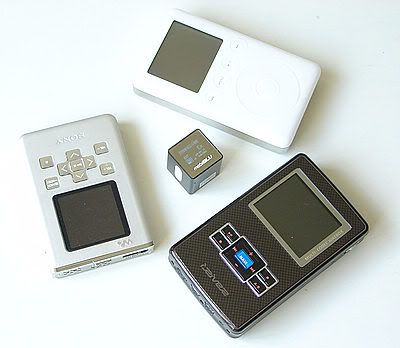
Is that a pool cue chalk? No, it's an MP3 player.
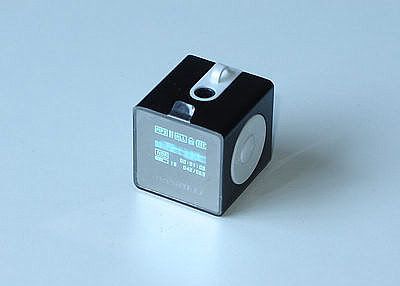
At 24mm cubed (under a cubic inch), Korean-based Hyun Won's mobiBLU DAH-1500 claims to be the world's smallest MP3 player. It probably is the world's smallest in terms of the features it offers. Just for sheer 'wowsers' factor the DAH-1500 has everything else beat, especially with the OLED display taking up one side of the 'dice'.
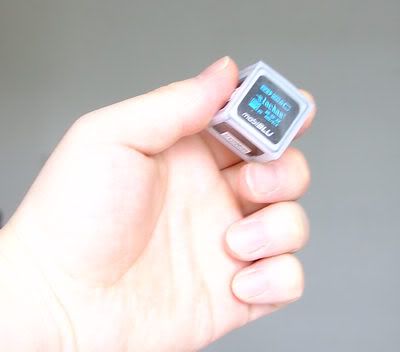
(DAH-1500 in supplied silicone 'crate case')
However, it's not all about looks. The specs are impressive too. Despite the diminutive size, the DAH-1500 is available with 256MB, 512MB and 1Gb of flash memory. I'm reviewing the 1Gb version. It will play MP3 from 8-320Kbps bitrates, and (unsecured) WMA files of 32-192Kbps. It has an FM radio with presets, is powered by an onboard rechargeable Li-Ion battery, and claimed weight is 12g. As posted on other sites and on my Maul mail scale, it actually weighs 18g.
The DAH-1500 is also available in a wide variety of colours, the availability of which may vary. I got the black by default, but the other colours look nice too.
Super-Easy Connectivity

After you get it home, the first thing you'll need to do is to load and charge it. Attaching the DAH-1500 to the PC is via an innovative USB connection. It's actually built into the headphone socket. So you have a special USB > 3.5mm jack cable that ships with the player. This charges and also connects the player. The DAH-1500 is a Universal Mass Storage device and therefore is recognised without drivers by most modern PC's. Should you still be clinging to Win98, Hyun Won supplies a CD with drivers. Charging takes around 3.5 hours, and the battery is rated for a mamimum of 17 hours.
Unexpectedly Usable
Press and hold the Play button and the player comes to life. The first thing you'll notice is the OLED display. This uses exactly the same type of display as the iRiver N10, albeit an abbreviated version. In direct daylight and generally while outside in bright weather the display is totally invisible, and is dimmer than the Sony flash player's OLED display. Indoors and at night, the display is very legible and is a nice blue.
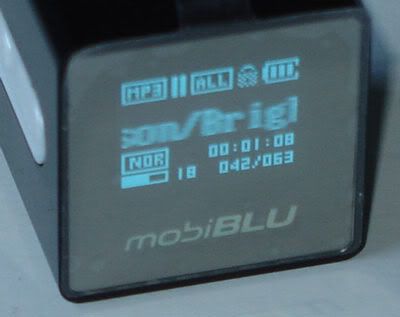
What's shown on the display is limited, but thanks to a well-judged scrolling speed and response, it's surprisingly usable especially after you learn the menu layout... after which you only need to hang around to see the track names. The song title display can be switched to read ID3 tags and to show it in an album/artist/song format, or just to show the filename.
The transport controls are on the right hand side of the cube, and consists of a simple circular pad with the play/pause button in the middle, and +, fwd, -, rwd controls in clockwise order. The left hand side of the cube has the menu button and the hold/clock display button. Although the menu structure and user interface design is quite similar to the iRiver N10, the separation of controls like this into a logical 'cluster' makes it significantly easier to get to grips with.


Tracks are played either in an unsorted (i.e. order as loaded) or in alphanumeric filename order in any folder. So if you want albums to play in sequence you'll either have to drag them over in the correct order, or rename the tracks with the track number at the front. Repeat modes are available for per track, per folder and all tracks. Shuffle also allows for selection within a folder or all tracks.
The player does support resume play, and even when switching between radio and MP3 playback, it will start from where it left off. There's a sleep option to switch it off after a preset time, and the player even switches off automatically after a while if you unplug the headphones.
The DAH-1500 recognises nested folders, so unlike some Creative flash players you can put music more than one folder deep. It's therefore very drag & drop friendly. The navigation is easy enough, despite the chopped-off display. No real complaints at all in the User Interface implementation.
FM radio is as well implemented as any other flash player of this type. There's an autoscan option which is reasonably quick and does pick up stations quite well, although signal pickup is largely dependent on your earphones as the cable is used as the aerial. The DAH-1500 does not record FM.
Surprisingly Not Bad Sound
I didn't think it was really worthwhile reporting on this player with my reference headphones as the basis, so my opinions in this review comes primarily from my time using it with the Sennheiser PX200.
The surprising thing given it's size and concerns over the doubled-up USB socket/headphone jack is that it doesn't sound crappy. Not the best I've heard, but certainly not the worst. Not bad at all actually. The sound is pretty clean, and as dynamic as a headphone amp of this size can be. All-round resolution is decent, trebles are well represented without being brittle or over-bright, and while the bass is not lacking, it does not unnecessarily boost it unless you want.
All in all you won't be losing anything (if at all) in sound quality compared to the vast majority of the better flash players. I'll do a more detailed listening test later and post if there are any surprises or nasties lurking but so far, it seems to play everything I throw at it and handles them with aplomb. At this stage, I can't hand on heart say it's a standout in terms of sound quality, but it is definitely more than acceptable.
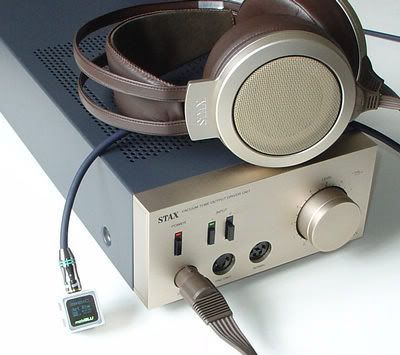
I had to try it with my one of my reference phones, the Stax Omega II.
Plenty of comedy value from a source smaller than the volume knob :)
The player has 5 preset EQ modes as well as a user-definable setting, although this is limited to controlling bass and treble. However, unusually in a player of this type you get the option of cutting bass and treble as well as boosting, with the controlling range being +/- 7db. As a result, you won't get the pounding bass of iRiver's UBass modes but the included modes are effective enough without entering overkill territory. All the presets are musically usable, which is I think a first in my experience.
The maximum headphone amp power is quoted to be 15mw into 16 ohms, but it feels like a lot less. As a result, it will not work well with power-hungry headphones, although even with a variety of phones there was no distortion when volume was pegged at full. But you're better served sticking to buds, canalphones or efficient portable phones in any case.
Track gaps are a fairly noticeable couple of seconds so may bother some, and it is probably enough to temporarily dampen the 'ambience' of an album in many cases. The player fast forwards and rewinds pretty quickly (about 1.5 minutes a second's worth after an initial slower startup, which is good) which is useful for skipping boring bits in Podcasts and mixes, but no sound is heard while doing so.
The DAH-1500 ships with a necklace-integrated headphone, which is not quite as clever as the similar solution on the iRiver N10, but nevertheless it does it's job. The phones aren't great, but they don't suck too badly either... just typical buds, nothing special. Thanks to the cuboid shape of the player however, it doesn't face the direction you want while on the neck as it keeps turning around, and it's sharp corners can bang your chest if you run around with it. The lanyard attachment point is a simple plastic loop so could be used with other neckbands.

The Catch?
You're saying... this can't be right! There must be a catch? Well yes, there is one major catch. Loading is pretty slow compared to many present-day USB 2.0 flash memory keys as it's a USB 1.1 device. However, the big surprise is that it's actually not very different in loading speed compared to the new Sony NW-E400/500 flash players, which are supposed to be USB 2.0. Battery life also falls short of the quoted maximum, but that's almost a given these days. ~14 hours was possible with low-bitrate Podcasts / my Internet radio recodings, with fairly minimal fiddling for volume and such. With varying degrees of fiddling, higher-bitrate MP3's and aftermarket phones, you can probably expect closer to 6~10 hours... but still, not bad.
In Closing
You expect something with such a small size usually to have a number of crippling compromises which prevent it being anything beyond a novelty toy which you tire of after a week's use. What surprises about the mobiBLU DAH-1500 is that remarkably few corners have been cut to achieve the size. The main cut corner is of course the display which had to be shortened over regular MP3 players, but the use of speedy text scrolling with a 'just right' speed at the 'Twice' mode means that it's very usable all the same. The USB1.1 transfer speed also turned out to be significantly less of a handicap compared to all but the Creative USB2.0 flash players (which are very fast to load).
Just don't lose the USB cable, and you'll find this a surprisingly daily-use friendly player.
Manufacturer Link: Mobiblu
Saturday, July 02, 2005
iTunes 4.9 with Podcast facility has told me...
... that all geeks talk like Kermit when they're in front of a mic.
Don't sit bolt upright when you're recording. Loosen up those lungs for christ's sake.
Edit: I admit this is a lame post, but so many people audioblogging or podcasting haven't figured out how to speak on-air. It only takes a listen to your podcast to realise what's wrong. That kermit voice from even regular-voiced people is due to nervousness or a 'stiffening up' when talking.
Don't sit bolt upright when you're recording. Loosen up those lungs for christ's sake.
Edit: I admit this is a lame post, but so many people audioblogging or podcasting haven't figured out how to speak on-air. It only takes a listen to your podcast to realise what's wrong. That kermit voice from even regular-voiced people is due to nervousness or a 'stiffening up' when talking.
Friday, July 01, 2005
Logitech Mediaplay Mouse
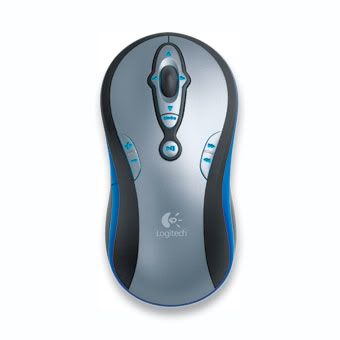
(Credit: Logitech)
Why a mouse review on an audio blog? When it has transport controls of course :-) The Logitech Mediaplay Cordless mouse is, as it's nomenclature suggests, a wireless mouse designed for media playback.
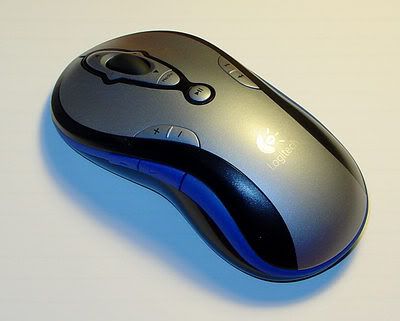
The mouse is shaped like a sleek running shoe and is symmetrical in shape. It has the usual left/right mouse buttons as well as the forward/back buttons found in many aftermarket mice, but it also has a play/pause button, a ffwd/rwd button, and a volume button. There's also a button to start the media browser of your choice. The placing of the additional control buttons are very good, as they don't get in the way of regular mousing duties and are difficult to press by accident. The media buttons are backlit, so when you press any of the media buttons (not the regular mouse buttons) they light up with a blue glow.
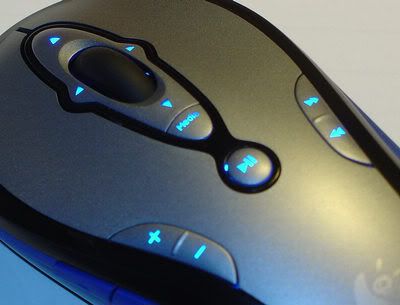
Installation is simple. Install the drivers and software first, then connect the wireless receiver. The receiver is of the USB stick type, so it can be plugged straight into a laptop, but a desktop extender is also supplied. The software includes Logitech's take on a '10 foot' software (i.e. a media playback software which you can control/see from 10 feet away). It's usable and looks nice enough but I didn't really get into it much.
Getting the mouse to work was totally painless, as was configuring the buttons. However the configuration of the mouse is not totally freeform as the buttons all have a fairly narrow range of selectable roles. The media player you can start up by using the button is also limited to the players that the Logitech player recognises. On the test laptop it picked up Winamp, iTunes, PowerDVD, RealOne and Windows Media Player as controllable applications, but it did not pick up Foobar, Mediasource, Sonicstage, Rio Music Manager, Media Center and numerous others. I stuck to iTunes.
It's always the little things that makes a difference in life. The handiness of being able to move through my playlist and seek through long podcasts, then pause playback to take calls... all without my hand leaving the mouse gave me an oddly fulfilling sense of control. I know it's just a glorified basic remote, but it just made me happy. Yeah, I'm a sad, sad geek.
There's just one fly in the ointment for those of you using separate DACs via a coaxial or optical out from your PC. The mouse software only affects the master volume, which means that in some such set-ups the volume control will not work (the wave volume needs to change).
Apart from the transport controls, The mousey bits are also quite good. The mouse uses invisible light for sensing movement, so no bright lights will flash up under the mouse. Tracking is decent, scroll wheel response is good and the scroll wheel is the latest tilting type, which works well when wading through the mammoth Excel spreadsheets that I have to do on a regular basis. I can't say I'm a huge fan of the pivotless left/right mouse buttons which I think are stiffer than they need to be, but it's a minor gripe. No idea how long batteries last yet, but from my usual experience Logitech mice don't have spectacular life compared to many of Microsoft's recent efforts. So it's rather thoughtful of them to provide an on/off button on the bottom for when you're not using it for a while.
If you are an audio nut and you listen on your PC a lot, the Mediaplay mouse is very simple in execution yet surprisingly usable. I like it and while it's not one of those 'must have' things, I'd recommend you take a look the next time you're hunting for an aftermarket mouse.
Link: Logitech US Site
Subscribe to:
Posts (Atom)
